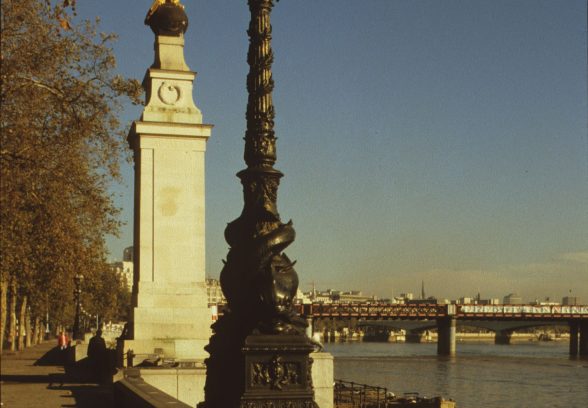This website uses cookies
This website uses cookies to enable it to function properly and to analyse how the website is used. Please click 'Close' to accept and continue using the website.



London: Royal Air Force Memorial
Status: Listed Grade II
Architect: Sir Reginald Blomfield, William Reid Dick (Sculpture), Parlanti (Founder), 1923
Location: Embankment, London
The memorial comprises a Portland stone plinth topped with a gilt bronze eagle and darkly patinated globe. The motto of the RAF, PER ARDUA AD ASTRA (‘Through struggles to the stars’) is inscribed around the frieze of the pylon.
The first RAF Memorial Committee was set up in February 1919, to respond to the suggestion of Maj. Gen. J. M. Salmond that the force should have its own chapel in London. Architects Edwin Lutyens and W. D. Caroe were considered. When the cost became too high, they decided to build an ‘ordinary memorial’, separate from the anticipated Cenotaph. Prince Albert (later George VI) was patron. The sum looked for was £40,000, but not all of this was to be spent on the memorial itself. Other objectives were the creation of boarding schools for the children of airmen, the provision of bursaries for the children of officers, and treatment and assistance for the disabled.
The pylon form which Blomfield proposed had already been used by him for war memorials for Torquay and Luton, on each occasion crowned with a different feature. The form had recently been given perfected minimal treatment by Lutyens in his Cenotaph for Whitehall, nearby. Blomfield found Whitehall Steps “a beautiful site”, but one which imposed limitations. The need to leave free access space around the memorial limited the dimensions of the base, and this in turn, determined the height to which the pylon could be carried without injuring its proportions. The required height could only be achieved by the addition of the eagle and globe.
The original design shows that the first intention was to have the eagle facing in towards the Embankment and away from the river, but Blomfield seems to have decided at a late hour that the Eagle would look better taking off over the river. Reid Dick’ was the architect’s choice, but his inventive input was limited; the eagle was based on a painting by ornithological artist, Archibald Thorbum. The unveiling was performed on the 16 July 1923 by the Prince of Wales, he referred to the way in which those commemorated had “played their part in the war, braving with high spirit the unknown dangers of warfare in a new element and dying to give us the final victory”, and to the tradition which their exploits and undoubted courage had established for the new “cloud armies of the future”.
William Reid Dick (1878-1961) trained in a stonemason’s yard before attending the Glasgow School of Art, exhibiting in London from 1907. From 1916-1918 he served in France and Palestine. In the inter-war years he distinguished himself in monumental architectural sculptures, notably the Kitchener memorial Chapel of St Paul’s cathedral (1922-25) and Unilever House (Lomax-Simpson and Sir John Burnet, 1930-1) . He was responsible for a number of sculptures and memorials, including statues of George V (1947) and President Roosevelt (1950) in Westminster.
Jon Wright
English Heritage Listing Entry
Either enter the name of a place or memorial or choose from the drop down list. The list groups memorials in London and then by country

Become a C20 member today and help save our modern design heritage.